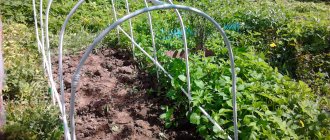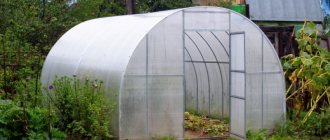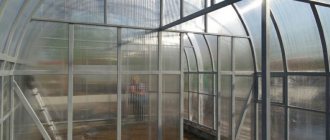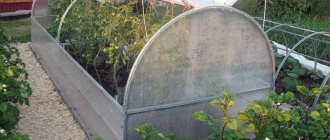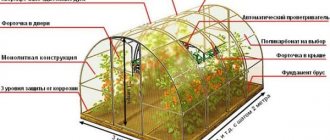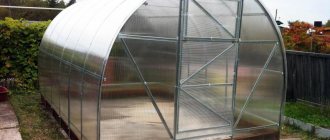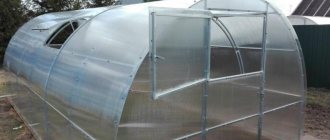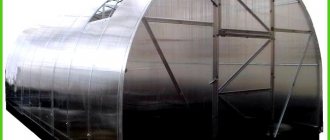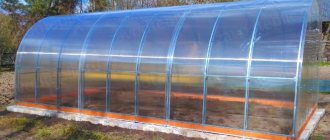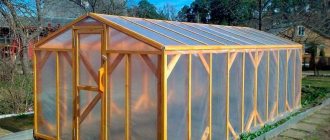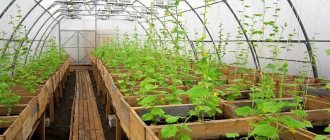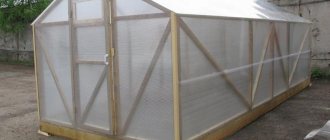Have you ever thought that the yield of your dacha will depend on the shape of the greenhouse? No, we are not talking about the length and width of the building - we are talking specifically about its shape. The pyramid greenhouse has long been known to experienced gardeners as a structure that truly increases productivity. And indeed, the fact remains that plants grow much better in structures of this particular shape. Therefore, today we will talk about how to create a greenhouse-pyramid on the site with your own hands.
Greenhouse-pyramid
Features of the pyramid greenhouse
Many gardeners with experience pay attention to the fact that the yield level in such cases increases by an average of 45%.
Another pleasant feature is that even with prolonged work in such a design, fatigue is practically not felt.
At the same time, one should not lose sight of the fact that this type has both advantages and disadvantages.
Caring for strawberries in vertical beds
Strawberries should be maintained in the same way as those growing in horizontal beds.
There are nuances of care, we will consider them.
- Watering. Since there is little soil in the boxes, it dries out faster. The frequency of irrigation will need to be determined experimentally, examining the soil every day. Water carefully from a bottle or watering can. It is best to arrange drip irrigation with adjustable droppers. Then the plants will receive a certain portion of water.
- Feeding. Soil depletion in vertical beds occurs faster. Therefore, fertilizers must be applied frequently. Liquid solutions are combined with watering and applied once a week. The nutrient solution is diluted with organic water in a ratio of 10:1. Mineral fertilizers are diluted according to the instructions.
- Pyramid beds do not require weeding.
A vertical bed with strawberries is installed in a sunny place, away from trees.
Pros of a pyramid greenhouse
Initially, it should be noted that this form has an attractive aesthetic appearance. Thus, by spending relatively little time and resources, it becomes quite possible to ensure the uniqueness of the site and give it a certain mystery.
Additional benefits include:
- High level of efficiency;
- Compact dimensions;
- Formation of a slight shadow, which makes it possible to effectively install next to greenhouses made in a different form;
- Plants growing in such a structure, as a rule, cannot overheat;
- Ability to create optimal humidity levels;
- Creating a unique climate.
Thus, when choosing this option, it is quite possible to ensure a high level of yield, but at the same time not to make excessive efforts.
Covering vertical strawberry beds for the winter
You can’t just leave a pyramid with seedlings over the winter. A thin layer of soil will freeze and the strawberries will die.
Before frost, the bed is covered with agrofibre and spruce branches on top.
Craftsmen build a vertical bed on wheels. Then such a structure is simply rolled into an outbuilding until spring.
Over time, the novice gardener will gain his own experience. And he will have his own methods and secrets of growing strawberries in a pyramid-bed.
Watch the video: multi-tiered strawberry bed
You may also find the following materials useful:
- What to put in the hole when planting strawberries?
- Everything you need to know about watering grapes in the summer
- Why doesn't apricot bear fruit? Basic ways to solve the problem
- Formative pruning of the currant crown will provide all parts of the plant with sunlight
- Fertilizing strawberries: from bud formation to fruiting
Cons of a pyramid greenhouse
Despite the fact that such designs are constantly gaining an increasing number of fans, one should not lose sight of the presence, albeit insignificant, of a number of shortcomings.
The main ones are:
- Relatively small in size.
- Due to the small area, certain problems may arise associated with the simultaneous cultivation of several types of plants.
- If all existing rules are not followed, a certain situation may occur in which the corresponding structure may collapse to one side, which will lead to negative consequences.
How to make the right foundation?
A pyramidal greenhouse is always placed directly on the ground, and only for its too bulky variants a foundation is needed. The strongest “field” for influencing plants and their seeds is supposedly located at 1/3 of the height from the top and from the base.
The supporting beams of the pyramid also serve as supports for plants. And the greenhouse itself does not necessarily have to be solid - it can have a removable cap, which is raised when necessary to ventilate the greenhouse.
Pyramid greenhouse dimensions
In appearance, such a greenhouse consists of 4 side frames that are connected together. In this case, a square base is initially installed. Subsequently, the entire structure under consideration is covered with film or polycarbonate.
- In order to give the frame additional rigidity, the frame is strengthened using wooden slats.
- At the same time, you should not lose sight of the fact that the entrance door is placed in one of the frames.
- To ensure better ventilation, it is extremely important to equip a window.
In the process of forming a greenhouse, it is extremely important to remember that its dimensions must comply with the “golden ratio” rule.
Therefore, it is extremely important to either carry out all the necessary calculations yourself, or, if this is not possible, seek help from an appropriate specialist.
Compliance with the golden ratio
Without going into details, let's say that the most important thing in this structure is compliance with the principle of the golden ratio and correct orientation to the cardinal points.
Schematic diagram.
Reference: the golden ratio in pyramids is considered to be the ratio of the diagonal at the base of the structure to the height of the structure. It is equal to 0.62.
To make your work easier, we ourselves calculated the dimensions of the pyramid greenhouse, using them it will be much easier for you to build your brainchild. And the structure you build will already have the necessary proportions.
READ ALSO: The Sun: Biden stumbles and nearly falls again while boarding Air Force One
| Design options | Height size | Base size | Fin size |
| Option 1 | 1.5m | 2.35m | 2.24m |
| Option 2 | 2m | 3.14m | 2.99m |
| Option 3 | 2.3m | 3.61m | 3.44m |
| Option 4 | 2.5m | 3.92m | 3.74m |
| Option 5 | 3m | 4.71m | 4.48m |
| Option 6 | 3.5m | 5.49m | 5.23m |
Calculation scheme.
For reference: the famous Pyramid of Cheops has a height of 146.7 m, a base size of 230.3 m, and an edge size of 219.2 m.
If you want to independently calculate the parameters of your brainchild, we will show you how:
- Naturally, there should be a square at the base of the building.
- The size of the side at the base is calculated as follows. The height of the building should be multiplied by 1.57075. You get the length of the side at the base.
- The edge is calculated in the same way, take the height and multiply by 1.4945.
In principle, everything is not so complicated.
Distribution of energy flows.
Step-by-step instructions for constructing a pyramid greenhouse
Anyone who wants to build a pyramid-type greenhouse on their own should have an idea that the following are the most common options:
- Mobile.
- Stationary.
Considering that the first option is best suited for growing seedlings (when it gets significantly warmer outside, they are transferred and planted in open soil).. In some cases, the other part still remains in the greenhouse, which ensures a faster harvest (moreover, in large quantities).
The main parameters required to calculate the size of the greenhouse are:
- Availability of 4 aluminum pipes and wooden beams;
- Measuring film;
- Polyethylene;
- Availability of wire and scissors.
With the help of such a kit it is possible to carry out not only measuring work, but also to ensure a complete process of performing preparatory work.
At the initial stage, it is necessary to determine the dimensions of the greenhouse and at the same time ensure that the areas are marked. As for the base of the structure, it must have only a square shape.
- After this, the prepared tubes, as well as bars, should be stuck into the ground along the perimeter of the marking. The optimal immersion depth should be at least 40 cm, but not more than 55 cm. Wires must be used to connect the upper parts of the tubes.
- After this, to form the covering of the side faces of the pyramid, it is necessary to cut 4 triangles from polyethylene. There must be a reserve in the lower parts so that they can be attached to the lower area.
- It is possible to fasten ready-made parts to the frame using special clamps or a construction stapler.
- Considering that such greenhouses are used, in most cases, for growing exotic plants, it is extremely important to pay attention to such a parameter as ventilation.
- To ensure this in a pyramidal greenhouse, it is necessary to bend the upper corners of the triangle to a height of about 10 cm.
If weather conditions significantly worsen (for example, excessive precipitation or a sharp drop in temperature), the corners must be bent and attached to the base of the frame. It is important that one of the triangles is secured in such a way that it can be used as a door.
It is worth noting that a more effective coating option is polycarbonate, which is capable of transmitting sunlight and maintaining a high temperature in the greenhouse for a long period of time. This option is especially relevant in the autumn-winter period, when significant temperature fluctuations are observed.
Materials and tools
As for the materials for creating a pyramid greenhouse, there are not as many as it seems.
- You need beams for the base in the amount of 4 pieces and dimensions 5 * 10 mm, as well as 4 boards of the same length with a cross-section of 15.4 cm.
- To create the foundation you will need cement, formwork boards, sand and gravel for the sand cushion. It is not necessary to use reinforcement at this stage.
- Buy a thinner beam from which you will make the remaining parts of the greenhouse - the frame, edges, door frame and doorway.
- As a covering material, you can use film, glass, polycarbonate in the amount necessary to cover the entire pyramid.
- It is also necessary to purchase canopies, handles, hooks that will ensure opening and closing of doors and windows, as well as their fixation.
- It is easier and more convenient to fasten all the parts of the greenhouse with self-tapping screws and corners. You will also need self-tapping screws for attaching polycarbonate.
Tools for building a pyramid greenhouse:
Prices for timber
timber
